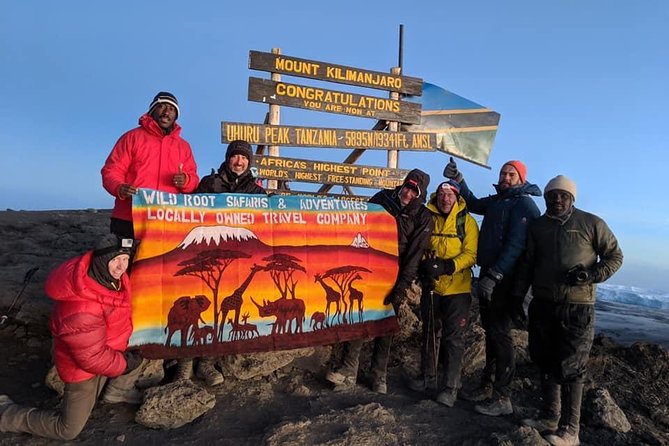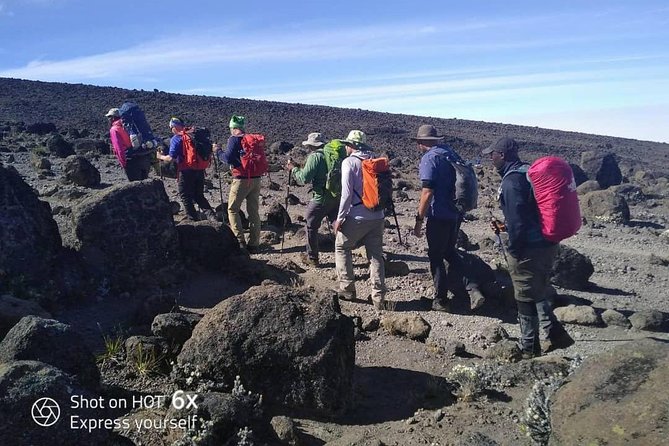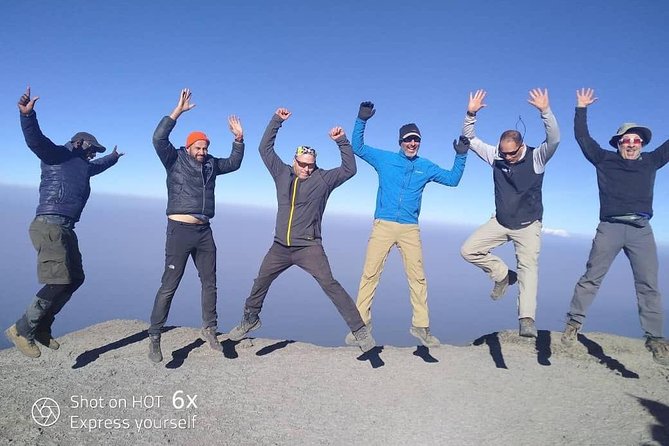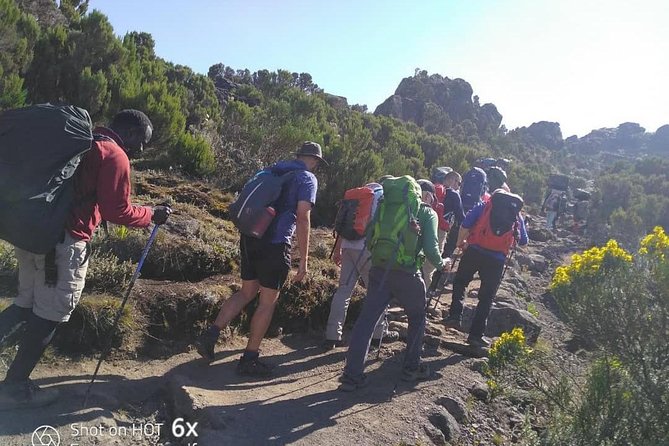Tackling the awe-inspiring Kilimanjaro requires meticulous planning, and the Lemosho Route offers an exceptional trekking experience. This less-crowded path traverses diverse landscapes, from lush rainforests to the stark beauty of the Shira Plateau, providing climbers with a scenic and gradual ascent. Proper acclimatization is crucial to avoid altitude sickness, and the Lemosho Route’s design ensures climbers are well-prepared for the final push to the summit. With breathtaking vistas, encounters with local wildlife, and expertly prepared meals, this adventure promises a rewarding challenge for seasoned adventurers. Discover why the Lemosho Route is the perfect choice for your Kilimanjaro expedition.
Good To Know

- The Lemosho Route is a scenic and challenging trek on Mount Kilimanjaro, approaching from the west and offering stunning views of the Shira Plateau.
- Proper gear preparation, including sturdy hiking boots and warm layers, is essential for a successful and comfortable climb on the Lemosho Route.
- The Lemosho Route’s gradual ascent and acclimatization days help climbers avoid altitude sickness, which is a significant risk on the mountain’s summit.
- The tour operator provides essential camping gear, such as tents and sleeping bags, while climbers should ensure their personal gear is in good condition.
- Memorable moments on the Lemosho Route include breathtaking vistas, encounters with wildlife, and the achievement of reaching the summit at Uhuru Peak.
Overview of Lemosho Route
The Lemosho route is one of the most scenic and challenging routes on Mount Kilimanjaro.
It’s a longer and more strenuous trek that approaches the mountain from the west, offering stunning views of the Shira Plateau. Trekkers will encounter a diverse range of landscapes, from lush rainforests to the barren, rocky terrain of the upper slopes.
The Lemosho route is less crowded than some of the more popular routes, providing a more serene and exclusive experience. With its gradual ascent, it’s an excellent choice for climbers seeking a more challenging and rewarding Kilimanjaro expedition.
The route’s remote starting point and extended duration make it a true adventure for experienced hikers.
You can also read our reviews of more tours and experiences in Arusha.
Preparing for the Climb

Climbers embarking on the Lemosho route should gear up thoroughly to ensure a successful and comfortable journey. Proper preparation is key, as the trek can be physically demanding. Hikers should pack the right equipment, including sturdy hiking boots, warm layers, and essential gear like headlamps and water bottles. To help guide the packing process, the table below outlines the recommended gear for the Lemosho climb.
| Essential Gear | Optional Gear |
|---|---|
| Hiking Boots | Gaiters |
| Insulated Jacket | Trekking Poles |
| Base Layers | Camera Equipment |
| Gloves and Hat | Snacks and Treats |
Following this packing list will help climbers stay comfortable and focused on the incredible journey ahead.
Day-by-Day Itinerary

With the proper gear in hand, the Lemosho route unfolds over seven days of trekking through diverse landscapes.
Day 1 begins at the Londorossi Gate, ascending through lush forests.
Days 2-3 continue the gradual ascent, crossing the Shira Plateau.
Day 4 leads to the Lava Tower, offering stunning views.
The challenging Day 5 ascends to Barranco Camp, while Day 6 tackles the Barranco Wall.
The final push to the summit occurs on Day 7, with the descent back to the trailhead on Day 8.
Proper acclimatization and a slow, steady pace are essential for completing this iconic Kilimanjaro trek.
Acclimatization and Altitude Sickness

Proper acclimatization is crucial for successfully summiting Kilimanjaro via the Lemosho route. Altitude sickness can occur at heights above 8,000 feet, and Kilimanjaro’s summit reaches over 19,000 feet.
To avoid altitude sickness, climbers must ascend slowly, take rest days, and drink plenty of water. The Lemosho route allows for gradual acclimatization, with climbers spending several days at lower altitudes before the final push to the summit.
Symptoms of altitude sickness include headaches, nausea, and fatigue. Climbers must be vigilant and communicate any issues with their guides.
Proper preparation and pacing are essential for reaching the top safely.
Gear and Equipment
Along With proper acclimatization, the right gear and equipment are key for a successful Kilimanjaro climb via the Lemosho route. Climbers should pack warm, weatherproof layers, sturdy hiking boots, and trekking poles.
Headlamps, water bottles, and snacks are also essential. The tour operator provides camping gear like tents, mattresses, and sleeping bags. Hikers should ensure their personal gear is in good condition before the trek.
Walking sticks and technical mountaineering equipment are available for rent. Packing the right items ensures comfort and safety on the challenging ascent. With the proper gear, climbers can focus on conquering the mountain rather than dealing with equipment issues.
Cuisine and Meals

Meals on the Kilimanjaro Lemosho route are prepared by the tour company’s experienced kitchen staff.
Breakfast, lunch, and dinner are included in the package, ensuring hikers are properly fueled for the day’s activities.
The meals feature a variety of local and international dishes, catering to different dietary needs.
Hikers can expect hearty meals like porridge, eggs, sausages, and fresh fruit for breakfast, packed lunches with sandwiches, snacks, and hot drinks, and dinner options such as stews, curries, and pasta dishes.
Bottled water is also provided throughout the trek.
The meals are designed to provide the necessary calories and nutrients to sustain climbers during the physically demanding Kilimanjaro hike.
Safety Considerations
Ensuring one’s safety is paramount when embarking on the Kilimanjaro Lemosho route. The trek poses several challenges that require careful preparation and attention to detail. The tour operator provides essential gear, such as tents, mattresses, and sleeping bags, to ensure a comfortable and secure experience.
Plus, the following safety considerations should be kept in mind:
-
Proper Acclimatization: Gradual ascent is crucial to allow the body to adapt to the high altitude, reducing the risk of altitude sickness.
-
Adequate Hydration: Drinking plenty of water is essential to maintain proper hydration and prevent dehydration.
-
Appropriate Clothing: Layering and wearing weather-appropriate gear can protect climbers from the unpredictable Kilimanjaro weather conditions.
Memorable Moments
The climb up Kilimanjaro’s Lemosho route offers a wealth of breathtaking vistas and unforgettable moments. Trekkers are rewarded with stunning panoramic views of the snow-capped peak, lush alpine forests, and vibrant wildflowers. Reaching the summit at Uhuru Peak is a true highlight, providing a sense of accomplishment and awe. Along the way, hikers may encounter local wildlife, including baboons, mongooses, and even the occasional elephant. To capture these special moments, the table below suggests some of the most photogenic spots and experiences:
| Location | Highlight |
|---|---|
| Shira Plateau | Serene alpine meadows and distant volcanic peaks |
| Barranco Wall | Challenging but rewarding rock scramble with dramatic backdrops |
| Uhuru Peak | Triumphant summit with unparalleled views of the African continent |
| Glaciers | Intricate ice formations and the receding glaciers’ impact on the landscape |
Frequently Asked Questions
What Is the Minimum Group Size Required for This Tour?
This is a private tour, meaning only your group participates. The tour doesn’t specify a minimum group size, so you can book it for your group regardless of the number of participants.
Can I Book This Tour With My Pet?
Unfortunately, pets are not allowed on this tour. The tour is designed for human participants only and cannot accommodate animals. Guests are advised to make alternative arrangements for their pets during the duration of the Kilimanjaro climb.
Is It Possible to Extend the Trip Duration?
Yes, it’s possible to extend the trip duration. The tour provider offers flexible scheduling and can customize the itinerary to accommodate longer stays. However, additional fees may apply for extending the trip beyond the standard package.
Can I Bring My Own Camping Gear?
Travelers can bring their own camping gear for the Kilimanjaro climb. However, the tour provider offers all the necessary camping equipment, so it’s not required. Bringing one’s own gear doesn’t impact the tour’s pricing or inclusions.
Do I Need to Purchase Travel Insurance for This Trek?
Travel insurance is not required, but it’s highly recommended to protect against unexpected costs like trip cancellation, medical emergencies, and gear loss. Many trekking companies can assist with purchasing a policy that covers the specific needs of the Kilimanjaro climb.
The Sum Up
The Lemosho Route on Mount Kilimanjaro offers a rewarding adventure. Its gradual ascent and diverse landscapes make it an excellent choice for properly acclimatizing and avoiding altitude sickness. Climbers can expect breathtaking vistas, wildlife encounters, and expertly prepared meals. With proper preparation and safety considerations, the Lemosho Route promises a memorable experience for all adventurers seeking to conquer the highest free-standing mountain in the world.
More Tour Reviews in Arusha
Not for you? Here's more nearby things to do in Arusha we have reviewed
- 3days Tarangire,Ngorongoro Crater and Lake Manyara
- Tanzania Budget Camping Safaris
- Tanzanite Gemstone Mining Experience at Mererani Mines Day Tour
- 7 Days Tour Northern Tanzania Safari:
- Ngorongoro Day Trip From Arusha / Kilimanjaro
- 3 Days Tanzania Private Big 5 Safari With Midrange Lodge
- Tanzania Tours Group Sharing 3 Days 2025/2026
- From Arusha : 3 Days Private Safari Tarangire N.P and Serengeti
- Full Day Olduvai & The Enigmatic Shifting Sand Tour
- 5-Day Classic Tarangire, Serengeti & Ngorongoro Camping
- 4 Days Serengeti Splendor Adventure
- Private Multi Day Serengeti Safari
